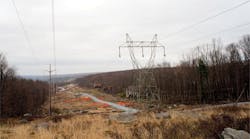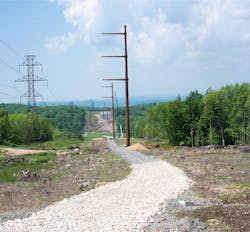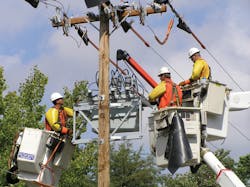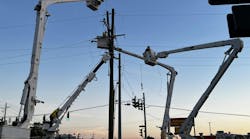From coast to coast, the nation’s electric infrastructure is beginning to show signs of aging. In turn, electric utilities are facing a decline in reliability and a spike in outages and the demand for repairs.
To provide improved operations and better service to its customers, PPL Electric Utilities is calling upon its field workforce to upgrade its system. The company is planning to spend $968 million this year, which includes about $616 million for transmission projects and $352 million to upgrade the distribution network. Over the next five years, the utility expects to spend $3.8 billion.
The utility invested $301 million in its system in 2009,$429 million in 2010, and $684 million in 2012 to construct new lines and substations, upgrade electrical facilities, and replace power lines and equipment. The investment in 2013, however, is said to be the largest infrastructure investment since the 1960s and 1970s.
PPL Electric’s employees are slated to work on 250 projects in 2013, and to successfully handle this workload, they’ll work alongside more than 1,500 other contracted tradespeople on the system. The workers will focus on projects that will help to minimize the number of outages experienced by the utility, strengthen the system and improve service to the utility’s 1.4 million customers in Pennsylvania.
Evaluating the Condition of the Infrastructure
A few years ago, PPL Electric took a close look at the age and condition of its transmission and distribution infrastructure, which is spread out over a 10,000-sq-ft service territory. Some of the utility’s 48,000 miles of power lines date back to the 1920s, before the advent of most of the heavy equipment and bucket trucks. As such, the utility’s linemen had to build some of the 80- to 90-year-old infrastructure by hand and haul equipment pulled by donkeys and horses.
The majority of the power lines, poles and equipment, however, were installed in the 1950s, 1960s or 1970s. While some of this infrastructure isn’t considered too old by most industry standards, the full life of a large power transformer is about 40 years.
“We saw that there was quite a bit of equipment that was approaching the end of its economic life,” says Gregory Dudkin, president of PPL Electric. “We knew we had to get ahead of the curve and start this investment plan now.”
PPL Electric took an inventory of the age of its assets and evaluated its increasing trend of equipment-related outages. When making the investment, Dudkin says the utility kept an eye to the future so it would have a more reliable system.
“The type of equipment that we are putting in has high reliability and low maintenance,” Dudkin says. “We are looking at smart grid equipment and a lot of automated devices that self heal. We are making decisions now that will impact the system in a positive way for a long time to come.”
Installing New Technology
For example, the workers are installing automated sectionalizing devices, which will reduce the impact to a smaller number of customers in the event of a problem with the system. If a tree were to come down and take out the utility’s circuit, it might affect 1,500 customers, but when the utility fully deploys its smart grid technology, the devices will be able to determine where the tree came down. In turn, they can open and close the switches to isolate the problem to a much smaller number of customers. So far, PPL Electric conducted a successful pilot project in Harrisburg, Pennsylvania, as well as in the Poconos.
“We identified where it will have the biggest impact, and we have it in our plans going forward,” Dudkin says.
PPL Electric has had advanced meters for many years. Back in 2002, the company installed a power line carrier system, which allowed it to transmit information to its customers about their usage and energy consumption patterns. As far as operating a transmission and distribution system, it enabled PPL Electric to ping the meter to see if it is on or not.
This year, the company is also installing a new distribution management system as part of its smart grid efforts and upgrading its outage management system, a critical computerized tool that helps employees respond to storm emergencies.
Strengthening the System
In addition to installing the latest technology, the utility is also trying to harden its system so it can withstand severe storm events. For example, Hurricane Sandy affected 525,000 of the utility’s customers, and over the last two years, the company has had to contend with several big storms. Through the infrastructure upgrades, the utility is aiming to build a system that sustains storm events and has a lower incidence of power interruptions.
One way that PPL Electric plans to harden its system is through vegetation management. The company is investing $45 million in 2013 between transmission and distribution. As such, the company is taking a holistic approach and identifying how to remove the hazards. For example, the program is focusing on how the workers are trimming away from facilities and removing danger trees.
The utility has opted to be proactive with its tree clearing. For example, a few years ago, the company had a “wire zone border zone” approach for its 230-kV and 500-kV lines. Because the trimmers trimmed out to the right-of-way and eliminated vegetation management hazards, the utility experienced no interruptions on those transmission lines when Hurricane Sandy hit.
Forging Ahead with New Projects
With so many projects on the docket over the next few years, PPL prioritized the jobs based on reliability and customer needs.
On the transmission side, a substantial investment will be made on the 500-kV Susquehanna–Roseland line, which will run from Berwick, Pennsylvania, to Roseland, New Jersey. This project, which will create about 2,000 construction jobs, is scheduled to be on-line in 2015. This job is a joint project between Public Service Electric & Gas (PSE&G) and PPL Electric. While PPL Electric will install 100 miles, PSE&G will install the remaining 50 miles.
The new transmission line follows the path of an existing 85-year-old power line that is nearing the end of its useful life. The line also crosses about 4 miles of National Park Service territory, including the Delaware Water Gap National Recreation Area, the Middle Delaware National Scenic River and the Appalachian National Scenic Trail. To mitigate any impact to the land, the utilities will fund the purchase or preservation of thousands of acres of additional land. The new transmission line is one of seven power lines nationwide selected by the Obama Administration’s Rapid Response Team for Transmission. As such, it was designated a fast-track project, and the team streamlined the review and permitting of the new transmission line. This line is intended to relieve congestion on the grid and improve electric service in the Northeast.
As part of construction of the new power line, the workers are using a new implosive slicing technique rather than crimping the sleeves to connect spools of wire using a hydraulic press. Specialty contractors are securing the connectors to the wires with a controlled implosion rather than mechanical force. At the splice point, an implosive charge is wrapped around the wires and the sleeve. This work method is said to be faster, cheaper and, in the end, it creates a stronger splice on the power line wires.
As far as distribution, crews are working on a slew of projects ranging from replacing 12-kV circuit breakers to replacing poles. The utility is looking at all of its worst performing circuits from a reliability perspective and then putting together plans to improve the performance of the circuits and the level of service to its customers.
Training Its Internal Workforce
To handle the increased workload, PPL Electric is relying on its own internal workforce as well as outside contractors. For its new employees, the utility has a four-year training program that trains apprentice linemen to be journeymen.
To educate the field workforce about the new types of technology that will be installed, PPL Electric has a new building at its training center for its substation technicians. In this facility, the new workers can practice on the new substation equipment from switchgear to circuit breakers and gain valuable hands-on experience before they work on the actual equipment in the field.
Dudkin says that now is an exciting time for all employees to be part of PPL Electric.
“They are coming on board at an incredible time in our company’s history,” he says. “They will see all sorts of projects and will be installing state-of-the-art equipment. The sheer amount of work out there is unprecedented. It’s almost like someone getting drafted, and then within the first year, their team wins the Super Bowl. Our apprentices are coming in at an incredible time, and they’ll learn a great deal about the variety, scale and scope of work in the line trade.”
Not only the apprentices but also the journeymen will learn a lot by working on upgrading the utility’s infrastructure over the next few years.
“This is an exciting but challenging time, and we are making decisions that will provide benefits for many years,” Dudkin says. “We can make a big difference, and we need to be on top of our game. By taking advantage of this opportunity to upgrade our system, it has our employees excited because they are making it happen.” ♦
Read the complete Linemen supplement in the September 2017 issue.





